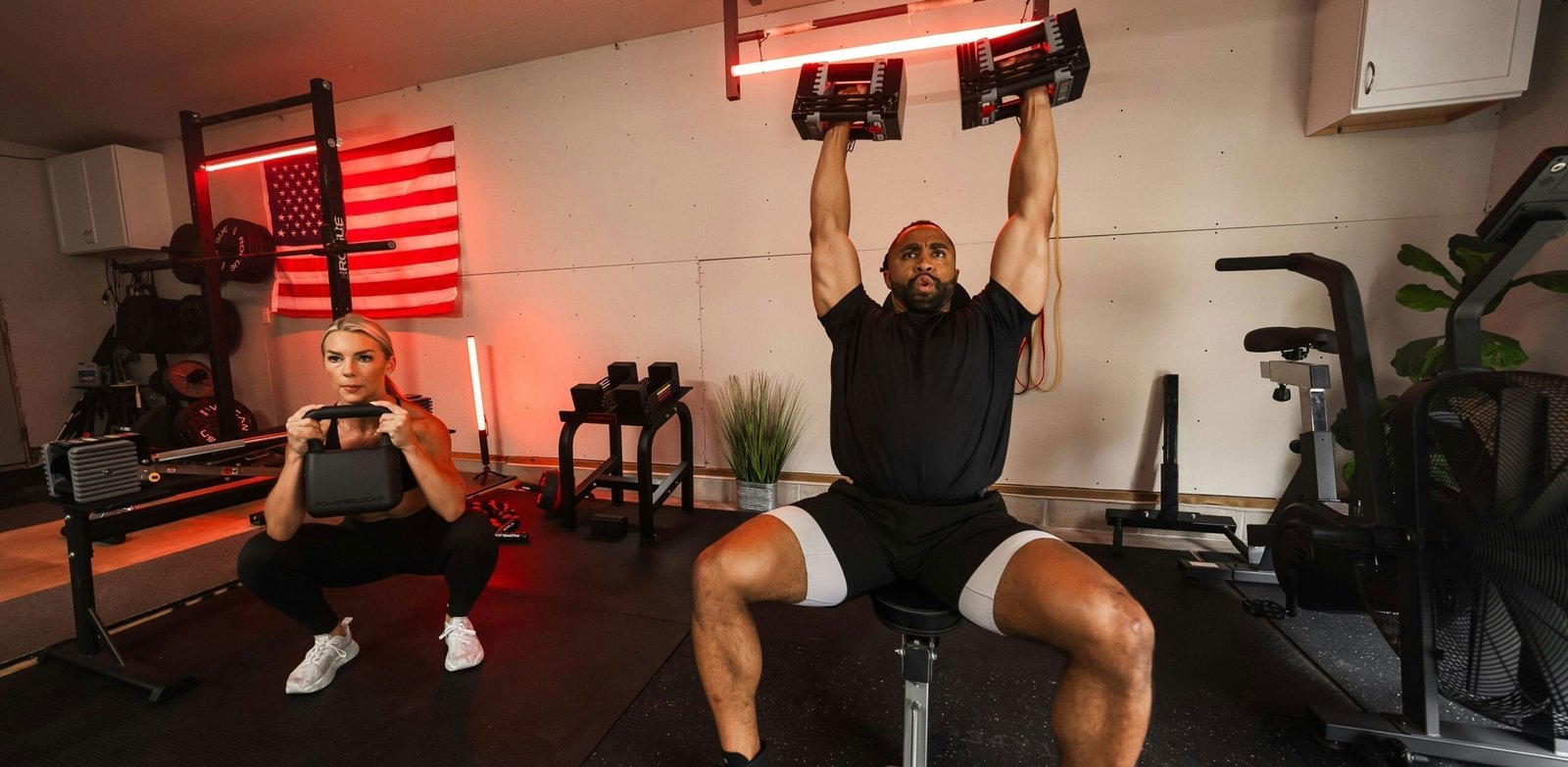Choosing the right dumbbell weight can make or break your workout. If the weights are too light, you won’t see progress.
If they’re too heavy, you risk injury or burnout. So, how heavy should dumbbells be for your workout? This guide will help you find the perfect balance to challenge your muscles and keep you motivated. By the end, you’ll know exactly what weight fits your goals and fitness level—making every rep count.
Keep reading to unlock the secret to smarter, safer strength training.
Choosing Dumbbell Weight
Picking the right dumbbell weight is key for a good workout. The right weight helps you build strength safely and effectively.
Too light weights may not challenge you. Too heavy weights can cause injury or bad form.
Factors To Consider
Think about your body strength and fitness level. Your workout type also matters. Consider how many reps you want to do.
- Muscle strength and size
- Type of exercises
- Number of repetitions
- Joint health and injury history
Workout Goals And Weight Selection
Your goals guide your dumbbell choice. For building muscle, use heavier weights with fewer reps.
For endurance, choose lighter weights with more reps. For toning, pick moderate weights and medium reps.
- Muscle gain: heavy weights, 6-12 reps
- Muscle endurance: light weights, 15+ reps
- Muscle tone: medium weights, 12-15 reps
Experience Level And Weight
Beginners should start with light weights. This helps learn good form and avoid injury.
Intermediate and advanced users can lift heavier weights. Increase weight gradually as strength improves.
- Beginners: light weights, focus on technique
- Intermediate: moderate weights, increase challenge
- Advanced: heavy weights, push limits safely

Weight Guidelines By Exercise Type
Choosing the right dumbbell weight is key for a good workout. The weight depends on the type of exercise you do.
This guide helps you pick dumbbells by exercise type. It covers strength, endurance, and recovery.
Strength Training
Strength training uses heavier dumbbells to build muscle. Choose a weight you can lift 6 to 12 times with good form.
If you can easily do more than 12 reps, the weight is too light. Pick a heavier dumbbell for muscle growth.
- Beginners: Start with 5-15 pounds (2-7 kg)
- Intermediate: Use 15-30 pounds (7-14 kg)
- Advanced: Lift 30+ pounds (14+ kg) as able
Endurance Workouts
Endurance training uses lighter weights and more reps. This helps muscles work longer without getting tired.
Choose a weight that lets you do 12 to 20 reps with steady control. The last reps should feel challenging but possible.
- Pick weights about 50-70% of your max lift
- Focus on 12-20 repetitions per set
- Use lighter dumbbells for smaller muscles
Rehabilitation And Recovery
Recovery exercises use very light dumbbells to avoid strain. The goal is to improve movement and strength slowly.
Weights often start as low as 1-5 pounds (0.5-2 kg). Increase only when movement becomes easy and pain-free.
- Start with 1-5 pounds (0.5-2 kg)
- Focus on slow, controlled movements
- Increase weight gradually as strength returns
Testing Your Dumbbell Weight
Choosing the right dumbbell weight is important for a safe workout. The right weight helps you build strength without injury.
Testing your dumbbell weight lets you find what works best for your body and goals.
Trial And Error Method
Try lifting different weights to see what feels right. Start with lighter dumbbells and slowly increase the weight.
Pay attention to how your muscles feel during and after each set. This helps you find a challenging but safe weight.
- Begin with a weight you can lift 10 to 15 times easily
- Increase weight if the last reps feel too easy
- Lower weight if you cannot complete the set with good form
Signs Of Correct Weight
The right dumbbell weight lets you finish your reps with effort but no pain. You should feel tired but not strained.
Good form is a key sign. If you can keep proper posture, the weight is likely correct.
- You complete all reps without stopping
- Muscles feel worked, not overly sore
- No joint pain or sharp discomfort
- You maintain good posture during exercises
Adjusting Weight Over Time
Your strength improves with regular exercise. This means your dumbbell weight should change too.
Increase your dumbbell weight gradually to keep challenging your muscles and avoid plateaus.
- Increase weight when reps become too easy
- Change weights every few weeks based on progress
- Listen to your body to avoid injury
Common Mistakes When Choosing Dumbbells
Picking the right dumbbell weight is important for a good workout. Many people make mistakes that affect their progress and safety.
Understanding these common errors can help you choose weights that fit your strength and goals.
Using Too Heavy Weights
Choosing dumbbells that are too heavy can cause injury. It puts stress on your muscles and joints.
Using heavy weights often leads to poor form and less control during exercises.
- Increases risk of muscle strains and joint pain
- Reduces workout quality because form breaks down
- Can cause fatigue too quickly, limiting reps
Choosing Weights That Are Too Light
Using dumbbells that are too light may not challenge your muscles enough. This slows down strength gains.
Light weights can make workouts feel easy but less effective over time.
- Fails to build muscle strength and endurance
- Makes workouts less intense and less rewarding
- Can cause boredom and loss of motivation
Ignoring Form And Technique
Focusing only on weight and ignoring form can harm your body. Good technique helps you get the most from your workout.
Poor form increases injury risk and lowers exercise benefits.
- Leads to muscle imbalances and joint pain
- Reduces effectiveness of each exercise
- Prevents proper muscle engagement and growth
Tips For Progressing Dumbbell Weights
Choosing the right dumbbell weight is important for safe and effective workouts. Increasing weight over time helps build strength and endurance.
These tips will guide you on how to increase dumbbell weights properly during your training.
Incremental Increases
Increase dumbbell weight in small steps to avoid injury. Small jumps allow your muscles to adjust gradually.
- Raise weight by 2.5 to 5 pounds at a time
- Increase only when you can complete all reps comfortably
- Use heavier weights for larger muscle groups
Tracking Your Progress
Keep a record of your weights and reps. Tracking helps you see improvements and know when to increase weights.
- Write down weights used for each exercise
- Note how many reps and sets you complete
- Review progress weekly to adjust your workout
Balancing Different Muscle Groups
Use different weights for different muscles. Some muscles are stronger and need heavier dumbbells.
Balance your workout to avoid injury and improve overall strength.
- Use heavier weights for legs and back
- Use lighter weights for arms and shoulders
- Train all muscle groups evenly
Recommended Dumbbell Weights For Beginners
Choosing the right dumbbell weight is key for a safe workout. Beginners should start with light weights to learn good form.
Starting with the right weight helps avoid injury and builds strength gradually.
Women’s Starting Weights
Women new to weight training should begin with lighter dumbbells. This helps focus on technique and control.
Common starting weights range from 3 to 8 pounds, depending on the exercise and fitness level.
- 3 to 5 pounds for small muscle exercises like bicep curls
- 5 to 8 pounds for larger muscles like shoulders and legs
- Start lighter if unsure, then increase gradually
Men’s Starting Weights
Men who are new to dumbbell workouts usually start with heavier weights than women. This supports building strength safely.
Typical starting weights range from 8 to 15 pounds, based on the exercise type and fitness level.
- 8 to 12 pounds for smaller muscle groups like arms
- 12 to 15 pounds for larger muscles such as chest and legs
- Choose weights that allow 10 to 12 controlled repetitions
Adjustments For Age And Fitness Level
Older adults or people with lower fitness should pick lighter dumbbells. This reduces injury risk and improves comfort.
Fitness levels vary, so adjust weights to feel challenging but manageable for each set.
- Older beginners may start 2 to 5 pounds lighter than younger adults
- Increase weights slowly as strength improves
- Stop if you feel pain or lose form
Dumbbell Weight And Safety
Choosing the right dumbbell weight is important for a safe workout. Using weights that are too heavy can cause injury.
Pick a weight that challenges your muscles but still lets you keep good form. Safety should always come first.
Proper Warm-up Techniques
Warming up prepares your body for exercise and lowers injury risk. Spend 5 to 10 minutes warming up before lifting dumbbells.
Focus on dynamic movements that get your blood flowing and muscles ready.
- Arm circles
- Light jogging or marching in place
- Shoulder shrugs
- Bodyweight squats
Avoiding Injury
Use dumbbells that fit your strength level. Start with lighter weights to learn proper form.
Stop if you feel sharp pain or discomfort. Keep your movements slow and controlled to protect your joints.
- Lift weights that you can handle for 8 to 12 repetitions
- Keep your back straight and core tight
- Do not lock your joints during exercises
- Rest between sets to avoid fatigue
When To Seek Professional Advice
Ask a trainer if you are new to weightlifting or unsure about your form. They can help choose the right dumbbell weight for you.
See a doctor before starting if you have health problems or past injuries. Getting expert advice keeps your workouts safe.
- New to strength training
- Feel pain during or after workouts
- Have joint or muscle injuries
- Want a personalized workout plan


Frequently Asked Questions
What Weight Dumbbells Should A Beginner Use?
Beginners should start with 5 to 10-pound dumbbells. This weight range allows you to focus on form. As you build strength, gradually increase the weight. Always prioritize technique over lifting heavier weights. Listen to your body and progress at your own pace.
How Do I Choose Dumbbell Weight For Workouts?
Choose dumbbell weight based on your fitness level and goals. Start with a weight that challenges you without compromising form. If you can do 8-12 reps comfortably, it’s a good start. Adjust the weight as you gain strength and confidence.
Are Heavier Dumbbells Better For Muscle Growth?
Heavier dumbbells can promote muscle growth but aren’t always necessary. Focus on progressive overload to see results. Gradually increase weight, reps, or sets over time. Ensure proper form to avoid injury. Balance heavy lifting with lighter weights for endurance and muscle definition.
Can Light Dumbbells Be Effective For Strength Training?
Yes, light dumbbells can be effective for strength training. They allow higher reps and improved muscle endurance. Focus on form and control to maximize benefits. Combining light and heavy weights in your routine can yield balanced results. Adjust your workout to your goals and fitness level.
Conclusion
Choosing the right dumbbell weight helps you exercise safely and effectively. Start with a weight that feels challenging but allows good form. Increase weight little by little as you get stronger. Listen to your body to avoid injury. Consistency matters more than heavy weights at first.
Enjoy your workouts and celebrate small progress every time. Keep adjusting weights to match your fitness goals. This way, you build strength and confidence step by step. Simple, steady effort leads to lasting results.



